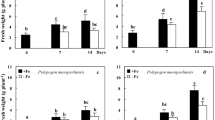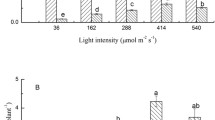Abstract
The effect of varied light intensity (50 – 600 μmol m-2 s-1) on the rate of phytosiderophore release was studied under zinc (Zn) deficiency using a bread (Triticum aestivum L. cv. Aroona) and a durum wheat cultivar (Triticum durum Desf. cv. Durati) differing in zinc (Zn) efficiency and under iron (Fe) deficiency using a barley cultivar (Hordeum vulgare L. Europe). Plants were grown under controlled environmental conditions in nutrient solution for 15 days (wheat plants) or 11 days (barley plants). Phytosiderophore release was determined by measuring capacity of root exudates to mobilize copper (Cu) from a Cu-loaded resin.
With increasing light intensity visual Zn deficiency symptoms such as whitish-brown lesions on leaf blade developed rapidly and severely in wheat, particularly in the durum cultivar Durati. In wheat plants supplied well with Zn, increases in light intensity from 100 to 600 μmol m-2 s-1 did not clearly affect the rate of phytosiderophore release. However, under Zn deficiency increases in light intensity markedly enhanced release of phytosiderophores in Zn-deficient Aroona, but not in Zn-inefficient Durati. When Fe-deficient barley cultivar Europe was grown first at 220 μmol m-2 s-1 and then exposed to 600 μmol m-2 s-1 for 24 and 48 h, the rate of release of phytosiderophores was enhanced about 4-fold and 7-fold, respectively. Transfer of Fe-deficient plants from 600 to 50 μmol m-2 s-1 for 48 h reduced the rate of release of phytosiderophores by a factor of 7. The effect of light on phytosiderophore release was similar regardless of whether the rate of phytosiderophore release was expressed per plant or per unit dry weight of roots.
The results demonstrate a particular role of light intensity in phytosiderophore release from roots under both Zn and Fe deficiency. It is suggested that in the studies concerning the role of phytosiderophore release in expression of Zn or Fe efficiency among and within cereals, a special attention should be given to the light conditions.
Similar content being viewed by others
References
Cakmak I, Gülüt K Y, Marschner H and Graham R D 1994 Effect of zinc and iron deficiency on phytosiderophore release in wheat genotypes differing in zinc efficiency. J. Plant Nutr. 17, 1–17.
Cakmak I, Atli M, Kaya R, Evliya H and Marschner H 1995 Association of high light and zinc deficiency in cold induced leaf chlorosis in grapefruit and mandarin trees. J. Plant Physiol. 146, 355–360.
Cakmak I, Sari N, Marschner H, Kalayci M, Yilmaz A, Eker S and Gülüt K Y 1996a Dry matter production and distribution of zinc in bread wheat and durum wheat genotypes differing in zinc efficiency. Plant Soil 180, 173–181.
Cakmak I, Sari N, Marschner H, Ekiz H, Kalayci M, Yilmaz A and Braun H J 1996b Release of phytosiderophores in bread and durum wheat genotypes differing in zinc efficiency. Plant Soil 180, 183–189.
Cakmak I, Torun B, Erenoglu B, Oztürk L, Marschner H, Kalayci M, Ekiz H and Yilmaz A 1997a Morphological and physiological differences in the response of cereals to zinc deficiency. Euphytica, 100, 349–357.
Cakmak I, Ekiz H, Yilmaz A, Torun B, Köleli N, Gültekin I, Alkan A, Eker S 1997b Differential response of rye, triticale, bread wheat and durum wheats to zinc deficiency in calcareous soils. Plant Soil 188, 1–10.
Erenoglu B, Cakmak I, Marschner H, Römheld V, Eker S, Daghan H, Kalayci M and Ekiz H 1996 Phytosiderophore release does not relate well with Zn efficiency in different bread wheat genotypes. J. Plant Nutr. 19, 1569–1580.
Graham R D, Ascher J S and Hynes S C 1992 Selecting zinc-efficient cereal genotypes for soils of low zinc status. Plant Soil 146, 241–250.
Gries D, Brunn S, Crowley D E and Parker D R 1995 Phytosiderophore release in relation to micronutrient metal deficiencies in barley. Plant Soil 172, 299–308.
Hansen N C and Jolley V D 1995 Phytosiderophore release as a criterion for genotypic evaluation of iron efficiency in oat. J. Plant Nutr. 18, 455–465.
Hansen N C, Jolley V D and Brown J C 1995 Clipping foliage differentially affects phytosiderophore release by two wheat cultivars. Agron. J. 87, 1060–1063.
Iturbe-Ormaetxe I, Moran J F, Arrese-Igor C, Gogorcena Y, Klucas R V and Becane M 1995 Activated oxygen and antioxidant defences in iron-deficient pea plants. Plant Cell Environ. 18, 421–429.
Kawai S, Takagi S and Sato Y 1988 Mugineic acid-family phytosiderophores in root-secretions of barley, corn and sorghum varieties. J. Plant Nutr. 11, 633–642.
Kissel M 1987 Eisenmangel-induzierte Abgabe von Phytosiderophoren aus Gerstenwurzeln als effizienter Mechanismus zur Eisenmobilisierung. Ph.D. Thesis, University of Hohenheim, Stuttgart, Germany.
Lytle C M and Jolley V D 1991 Iron deficiency stress response of various C-3 and C-4 grain crop genotypes: strategy II mechanism evaluated. J. Plant Nutr. 14, 341–362.
Marschner H, Römheld V and Kissel M 1986 Different strategies in higher plants in mobilization and uptake of iron. J. Plant Nutr. 9, 695–713.
Marschner H, Römheld V and Kissel M 1987 Localization of phytosiderophore release and of iron uptake along intact barley roots. Physiol. Plant 71, 157–162.
Mori S, Nishizawa N, Hayashi H, Chino M, Yoshimura E and Ishihara J 1991 Why are young rice plants highly susceptible to iron deficiency? Plant Soil 130, 143–156.
Mori S 1994 Mechanisms of iron acquisition by graminaceous (strategy II) plants. In Biochemistry of Metal Micronutrients in the Rhizosphere. Eds. J A Manthey, D E Crowley and D G Luster. pp 225–249. Lewis Publishers, Boca Raton, Florida.
Potvin C, Lechowicz M J, Bell G and Schoen D 1989 Spatial, temporal, and species-specific patterns of heterogenity in growth chamber experiments. Can. J. Bot. 68, 499–504.
Rengel Z and Graham R D 1995 Wheat genotypes differ in zinc efficiency when grown in the chelate-buffered nutrient solution. I. Growth. Plant Soil 176, 307–316.
Römheld V 1987 Different strategies for iron acquisition in higher plants. Physiol. Plant 70, 231–234.
Römheld V and Marschner H 1990 Genotypical differences among graminaceous species in release of phytosiderophores and uptake of iron phytosiderophores. Plant Soil 123, 147–153.
Shi W M, Chino M, Youssef R A, Mori S and Takagi S 1988 The occurrence of mugineic acid in the rhizosphere soil of barley plant. Soil Sci. Plant Nutr. 34, 585–592.
Takagi S 1976 Naturally occurring iron-chelating compounds in oat-and rice-root washings. I. Activity measurements and preliminary characterization. Soil Sci. Plant Nutr. 22, 423–433.
Takagi S, Nomoto K and Takemoto T 1984 Physiological aspect of mugineic acid, a possible phytosiderophore of graminaceous plants. J. Plant Nutr. 7, 469–477.
Takagi S, Kawai S and Yu M H 1988 Efficiency of iron extraction from soil by mugineic acid family phytosiderophores. J. Plant Nutr. 11, 643–651.
Treeby M, Marschner H and Römheld V 1989 Mobilization of iron and other micronutrient cations from a calcareous soil by plant borne, microbial and synthetic metal chelators. Plant Soil 114, 217–226.
von Wiren N, Römheld V, Morel J L, Guckert A and Marschner H 1993 Influence of microorganisms on iron acquisition in maize. Soil Biol. Biochem. 25, 371–376.
von Wiren N, Mori S, Marschner H and Römheld V 1994 Iron inefficiency in maize mutant ys1 (Zea mays L. cv. Yellow-Stripe) is caused by a defect in uptake of iron phytosiderophores. Plant Physiol. 106, 71–77.
Walter A, Römheld V, Marschner H and Mori S 1994 Is the release of phytosiderophores in zinc-deficient wheat plants a response to impaired iron utilization? Physiol. Plant. 92, 493–500.
Walter A, Pich A, Scholz G, Marschner H and Römheld V 1995 Diurnal variations in release of phytosiderophores and in concentration of phytosiderophores and nicotianamine in roots and shoots of barley. J. Plant Physiol. 147, 191–196.
Zhang F, Römheld V and Marschner H 1989 Effect of zinc deficiency in wheat on the release of zinc and iron mobilizing root exudates. Z. Pflanzenernāhr. Bodenk. 152, 205–210.
Zhang F, Römheld and Marschner H 1991 Diurnal rhythm of release of phytosiderophores and uptake rate of zinc in iron-deficient wheat. Soil Sci. Plant Nutr. 37, 671–678
Author information
Authors and Affiliations
Rights and permissions
About this article
Cite this article
Cakmak, I., Erenoglu, B., Gülüt, K. et al. Light-mediated release of phytosiderophores in wheat and barley under iron or zinc deficiency. Plant and Soil 202, 309–315 (1998). https://doi.org/10.1023/A:1004384712817
Issue Date:
DOI: https://doi.org/10.1023/A:1004384712817




